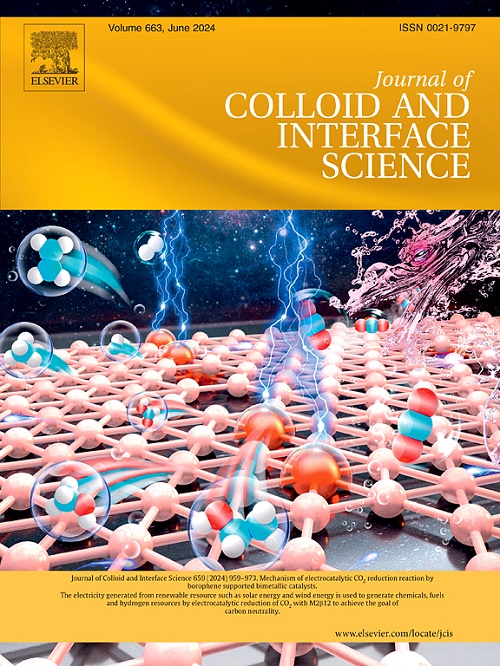Amorphous FePO4-anchored three-dimensional macro-porous Ti3C2Tx for superior capacitive deionization and sodium-ion selectivity
IF 9.7
1区 化学
Q1 CHEMISTRY, PHYSICAL
引用次数: 0
Abstract
Faradaic capacitive deionization (CDI), which exploits pseudo-capacitive electrodes, is an appealing water-purification candidate from low-salinity desalinated water due to its fast Faradaic electro-sorption and ion intercalations. However, current Faradaic CDI faces the challenge in low salt adsorption capacity and poor selective sodium-ion (Na+) applicability. Herein, amorphous ferric phosphate (FePO4)-anchored on three-dimensional macro-porous Ti3C2Tx network (3D FePO4@Ti3C2Tx) electrode is proposed without scarifying Ti3C2Tx electronic conductivity, wherein sodium-ion captured FePO4 provided abundant Na+ adsorption site for enhancing desalination capacity and Na+ selectivity. Simultaneously, highly-interconnected channels accelerated electron/ion transport to enable effective Na+ intercalation in electro-sorption. Accordingly, the assembled FePO4@Ti3C2Tx//activated carbon (AC) asymmetric CDI device delivered a typical Na+-intercalated behavior with high desalination capacity of 65 mg g−1, in which electric current generation could power a blue light-emitting diode (LED) screen. Importantly, the asymmetric CDI device enabled an evident Na+ selectivity over the Al3+ with high separator factor up to 6.3 in binary mixture feed of Na+ and Al3+. This study offers a new idea to achieve high desalination performance and sodium-ion selectivity via 3D framework supported ions-capture structure in seawater desalination.

非晶fepo4锚定的三维大孔Ti3C2Tx具有优异的电容性去离子和钠离子选择性
法拉第电容去离子(CDI)是一种利用伪电容电极的水净化技术,由于其快速的法拉第电吸附和离子插入,是一种很有吸引力的低盐度淡化水净化技术。然而,目前的法拉第CDI面临着盐吸附能力低和选择性钠离子适用性差的挑战。本文提出了在不破坏Ti3C2Tx电子导电性的情况下,锚定在三维大孔Ti3C2Tx网络(3D FePO4@Ti3C2Tx)电极上的无定形磷酸铁(FePO4),其中钠离子捕获的FePO4提供了丰富的Na+吸附位点,提高了脱盐能力和Na+选择性。同时,高度互联的通道加速了电子/离子传输,使Na+在电吸附中有效嵌入。因此,组装的FePO4@Ti3C2Tx//活性炭(AC)不对称CDI器件具有典型的Na+插层行为,具有65 mg g - 1的高脱盐能力,其中产生的电流可以为蓝色发光二极管(LED)屏幕供电。重要的是,不对称CDI装置使Na+对Al3+具有明显的选择性,在Na+和Al3+的二元混合进料中,Na+的分离系数高达6.3。该研究为三维框架支撑离子捕获结构在海水淡化中实现高脱盐性能和钠离子选择性提供了新思路。
本文章由计算机程序翻译,如有差异,请以英文原文为准。
求助全文
约1分钟内获得全文
求助全文
来源期刊
CiteScore
16.10
自引率
7.10%
发文量
2568
审稿时长
2 months
期刊介绍:
The Journal of Colloid and Interface Science publishes original research findings on the fundamental principles of colloid and interface science, as well as innovative applications in various fields. The criteria for publication include impact, quality, novelty, and originality.
Emphasis:
The journal emphasizes fundamental scientific innovation within the following categories:
A.Colloidal Materials and Nanomaterials
B.Soft Colloidal and Self-Assembly Systems
C.Adsorption, Catalysis, and Electrochemistry
D.Interfacial Processes, Capillarity, and Wetting
E.Biomaterials and Nanomedicine
F.Energy Conversion and Storage, and Environmental Technologies

 求助内容:
求助内容: 应助结果提醒方式:
应助结果提醒方式:


